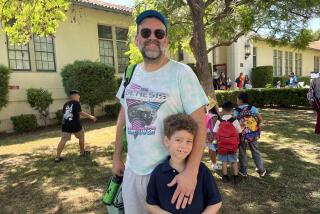Seismic Science Fair : Quake Gives Students a Real-Life Theme for Their Projects and They Use Some Unusual Tools to Capture Mother Nature’s Wrath
- Share via
She used cement blocks, water pipes, an alarm clock and a No. 2 pencil.
He used a laser, an electronic amplifier and a computerized graph recorder.
Still, Maritza Alvarado and Wiyanto Alamsyah had a lot more in common than it first seemed Tuesday when they found themselves standing next to each other in Downtown Los Angeles.
Both were finalists in this year’s $40,000 California State Science Fair. Both were waiting nervously for judges to come down the Sports Arena aisle and evaluate their work. Both had designed and built seismographs as high school science class projects.
And they were not the only ones with earthquakes on their minds. It turns out that the Jan. 17 Northridge temblor shook teen-agers throughout the state into thinking about seismic mysteries.
More than a dozen of the record 862 students competing in the fair tackled earthquake-related projects. That is apparently a record too, fair organizers said.
“I was going to do some dumb bacteria-sample thing. But then the earthquake came and I saw pictures of all the structural failures,” said eighth-grader Peter Kazanjy of Tustin. He used a piston-like device to simulate the effect of a quake on walls reinforced with plywood.
Benjamin Fischetti, 14, of Santa Barbara got the idea to experiment with reinforced concrete beams after looking at a huge rafter in his school gym Jan. 17 and wondering if a closer quake would have bent it.
The quake jolted Heather Broersma of Moreno Valley into action too. “I’d waited to the last minute to start a project and then along it came,” said the 15-year-old, whose study of aftershocks showed that all were centered north of the Northridge epicenter.
Teen-agers used unusual tools to simulate the ground-wrenching wrath of Mother Nature.
Tony Data, 13, of Redwood City used a battery-operated screwdriver, Kenny Bonnefin, 13, of Lone Pine borrowed his father’s power drill, and Kristopher Cox, 15, of Ridgecrest salvaged a record player motor from the trash.
Seventh-grader Stephanie Pichel of Half Moon Bay used a vibrating back massager to simulate a quake’s effect on various types of reinforcement that she used inside handmade adobe bricks.
A backpack’s elastic bungee cords attached to wooden blocks created the slamming motion that Denise Tung, 14, of San Diego needed to test the effect of base-isolation beneath buildings. For the “buildings” in her test, she used a stack of her mother’s mah-jongg game pieces.
When 12-year-old Sarah Hoffman of Bakersfield discovered that there were no earthquakes to test the seismograph she had made out of a tin can, springs and a felt-tip marker, she put the device in friends’ cars and measured the effectiveness of their shock absorbers.
None of the earthquake projects emerged as top winners. Those honors went to an oil contamination experiment by Clovis senior Lalia Abdelal, ocean research by senior Lulu Wang of Alhambra High School, and an aerodynamics study by eighth-grader Jennifer Bruno of St. Paul the Apostle School in Los Angeles.
Seismograph-makers Alamsyah and Alvarado emerged with their confidence unshaken, though.
Alamsyah, 16, of Pebble Beach, used electronic gear from his boarding school for his experiment. He said he intends to pursue seismic work with a career in petroleum engineering.
Alvarado, 14, of Pasadena, plans to place her homemade device in her back yard so she can keep track of aftershocks. She hopes to become a heart surgeon. But first she wants to write a thank you note to the guys at Home Depot in Monrovia.
“They were really angels. They drilled and cut all the pipes to my specifications. I couldn’t have done my project without them.”
More to Read
Sign up for Essential California
The most important California stories and recommendations in your inbox every morning.
You may occasionally receive promotional content from the Los Angeles Times.














